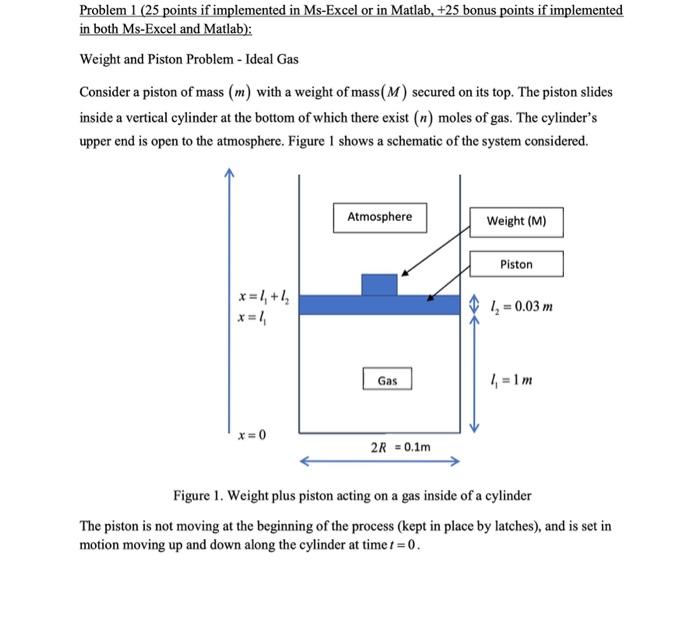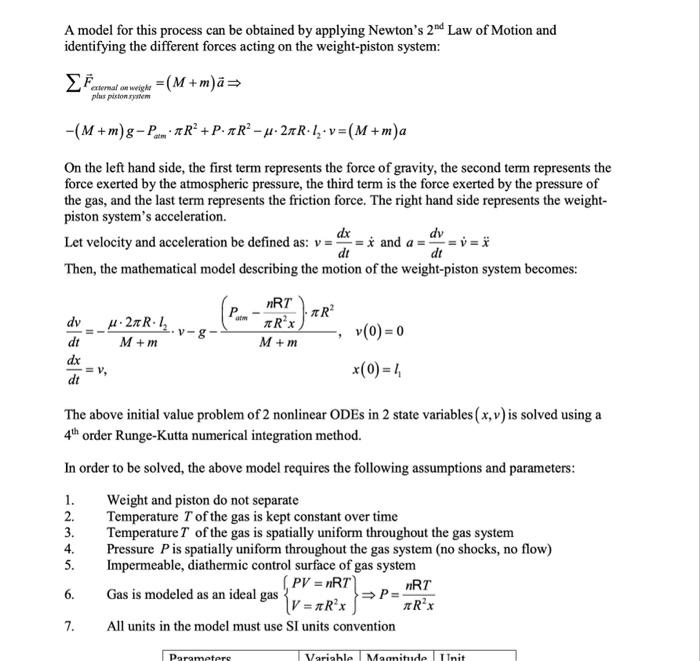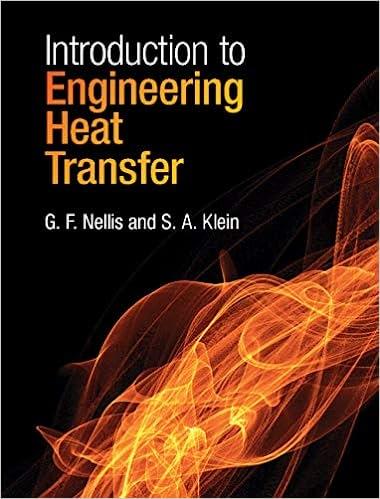Problem 1 ( 25 points if implemented in Ms-Excel or in Matlab, +25 bonus points if implemented in both Ms-Excel and Matlab): Weight and Piston Problem - Ideal Gas Consider a piston of mass (m) with a weight of mass (M) secured on its top. The piston slides inside a vertical cylinder at the bottom of which there exist (n) moles of gas. The cylinder's upper end is open to the atmosphere. Figure 1 shows a schematic of the system considered. Figure 1. Weight plus piston acting on a gas inside of a cylinder The piston is not moving at the beginning of the process (kept in place by latches), and is set in motion moving up and down along the cylinder at time t=0. A model for this process can be obtained by applying Newton's 2nd Law of Motion and identifying the different forces acting on the weight-piston system: (M+m)gPmemR2+PR22Rl2v=(M+m)a On the left hand side, the first term represents the force of gravity, the second term represents the force exerted by the atmospheric pressure, the third term is the force exerted by the pressure of the gas, and the last term represents the friction force. The right hand side represents the weightpiston system's acceleration. Let velocity and acceleration be defined as: v=dtdx=x and a=dtdv=v=x Then, the mathematical model describing the motion of the weight-piston system becomes: dtdv=M+m2Rl2vgM+m(PatmR2xnRT)R2,dtdx=v,v(0)=0x(0)=l1 The above initial value problem of 2 nonlinear ODEs in 2 state variables (x,v) is solved using a 4th order Runge-Kutta numerical integration method. In order to be solved, the above model requires the following assumptions and parameters: 1. Weight and piston do not separate 2. Temperature T of the gas is kept constant over time 3. Temperature T of the gas is spatially uniform throughout the gas system 4. Pressure P is spatially uniform throughout the gas system (no shocks, no flow) 5. Impermeable, diathermic control surface of gas system 6. Gas is modeled as an ideal gas {PV=nRTV=R2x}P=R2xnRT 7. All units in the model must use SI units convention Problem 1 Tasks 1. Calculate the quasi-static work done by the gas for different equilibrium states obtained by varying the weight's mass M, using the following equation Wgos,pasi-maic=nRTln(l1x), where the displacement x is obtained by solving the expression of mechanical equilibrium, g+M+m(PammR2xnRT)R2=0, for the weight-piston system. Consider that at the first equilibrium state, the initial weight mass is calculated as Minital=mg(PatmR2l1nRT)R2. Use increments of 102kg for subsequent M 's until you reach M=9(kg). Plot the quasi-static work done by the gas Wg as a function of displacement x. 2. For the above irreversible process, =1450kg/(m2s), employ the 4th order RungeKutta method to solve the above system of 2 ODEs in order to obtain the displacement and velocity (x,v) as a function of time for a time interval of 10 seconds, with a step size of 103 and for a weight mass of M=9(kg). Make plots of the displacement, velocity, and acceleration as a function of time. Calculate the work exerted by the gravity, atmospheric pressure, gas pressure, and the friction, as well as the change in kinetic energy. Next, add all the works and compare their sum to the change in kinetic energy. Also plot the four works, the sum of all the works, and the change in kinetic energy as a function of time. In addition, compare the quasi-static work of the gas for a weight of mass M=9(kg) to the irreversible work obtained when an equilibrium state is reached. 3. Consider a reversible process with identical parameter values, except that the friction coefficient is zero, i.e. =0kg/(m2s). Employ the 4th order Runge-Kutta method, to solve the above system of 2 ODEs in order to obtain the displacement and velocity (x,v) as a function of time for a time interval of 10 seconds, with a step size of 103 seconds and for a weight mass of M=9(kg). Make plots of the displacement, velocity, and acceleration as a function of time. Calculate the work exerted by the gravity, atmospheric pressure, and gas pressure, as well as the change in kinetic energy. Next, add all the works and compare their sum to the change in kinetic energy. Also, plot the three works, the sum of all the works, and the change in kinetic energy as a










